|
19TH CENTURY |

|
|
Copyright © Malcolm Fare 2005-2025
|
|
     
|
|
A unique piece of fencing history is a
French fencing master’s diploma or Brevet de Maitre. On the 11th
of August 1811 this was awarded to voltigeur (light infantryman)
Joseph Brault, who had qualified in Dartmoor Prison, the award being made
by 26 masters and fellow prisoners from the 47th Regiment
captured during the Peninsular War. |
|
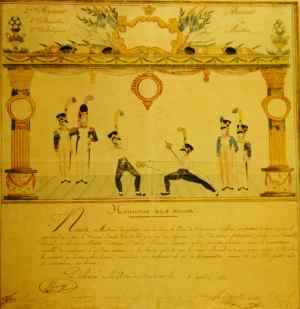
Brevet de Maitre, 1811
|
|
Among the 100 or so 19th century books in
the museum’s library is an anonymous manuscript entitled The Fencer,
dated 1838, by a pupil of William Angelo; the first works to introduce
epee and sabre to the fencing public; and a bound set of the early years
of the beautifully illustrated fencing magazine, L’Escrime Francaise,
1889-1895.
Pictures on show include three original watercolours of
fencers by the prolific French fencing artist Frédéric Régamey, as well
as Régamey’s famous print of the historic match in 1816 between the
Comte de Bondy and the provincial fencing master Justin Lafaugère. There
is a fine coloured mezzotint engraving of a Regency fencer by Francalanza
and a late 19th century watercolour of an impossibly
wasp-waisted French lady foilist by Jean Beraud. Rather more realistic is
the English fencer/artist Frederick Townsend’s watercolour drawing of
two ladies fencing under the watchful eye of their master, Baptiste
Bertrand. An oil painting by Francois Brunery shows Bertrand shortly
before he died in 1898. |
|
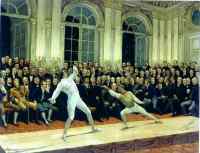
Comte de Bondy v
Lafaugere
1816
|
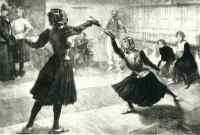
Lady foilists at Salle
Bertrand,1899
|
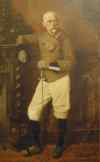
Baptiste Bertrand
c. 1898
|
|
The second half of the century saw an enormous variety
of fencing weapons appear on the market as a growing interest in the sport
was matched by the technology to produce virtually any style required.
Foils with finely embossed blades mounted in decorative hilts were made
for presentation or were specially commissioned by individual fencers.
A magnificent case of foils dating from the French
Second Empire period is lined with blue velvet and has the Napoleonic
eagle stamped in gold at either end. Probably made for the son of a
marshal, the beautifully decorated blades are just 74.5 cm long. |
|

Case of foils, c. 1860
|
|
One pair of English foils on display has
pineapple-shaped pommels and embossed blades stamped with a king’s head;
their solid brass butterfly shell guards bear the inscription A J
Richards, Radley College, 1862. The blades are among the first to be
stamped with the number 4 which, together with No. 5, began to appear on
foils from the mid-19th century. Why these numbers were chosen
and who began the practice is now lost in the mists of time.
Other foils on display have guards decorated with
acanthus leaves, anchors, military trophies, skull and crossbones,
geometric patterns and even winged cherubs entwined with serpents; pommels
include those in the form of a knight’s helm, plumed helmet, hooded
skull and female head with feathered headdress. |
|
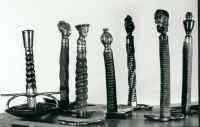
19th c. foil hilts
|
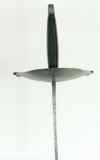
German, c. 1840
|
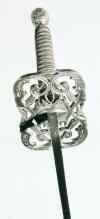
French, c. 1850 |
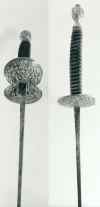
French, c. 1860 |
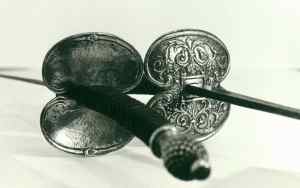
English, presented to A J
Richards, Radley College, 1862 |
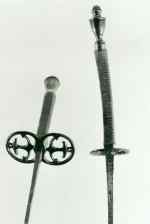
English, c. 1870 |
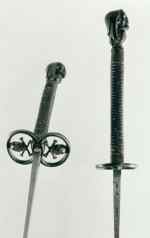
French, c. 1870 |
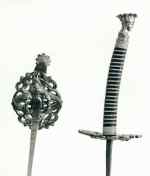
French, c. 1880 |
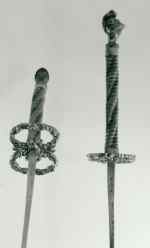
French, c. 1880 |
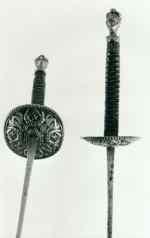
English, c. 1880 |
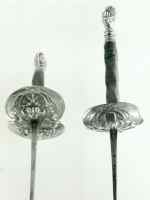
English, presented
to W J Bourn, 1887 |

Blade etched by Souzy, Paris, c. 1880 |

Blade blued and gilded by Wilkinson, Pall Mall, c. 1890 |

Decorative blade from Solingen, c. 1890 |

Elstree School prize from Angelo’s School of Arms, 1892 |
|
The last quarter of the 19th century saw the introduction of
epee and sabre as fencing weapons. The épée de salle was exactly
the same as its sharp counterpart except for the addition of a buttoned
tip and the museum has several early examples with comparatively small
steel cup guards. One ingenious design, well ahead of its time when
advertised in 1894, incorporates a square pin under the guard, which
secures the blade and can be easily unscrewed to allow a new blade to be
fitted. As well as heavy army practice swords and an example of the first
light fencing sabre, pairs of decorative French duelling epees and Italian
duelling sabres are on display. |
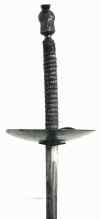
French epee,
c. 1870 |
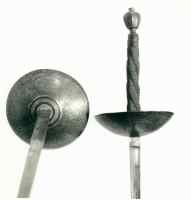
French duelling
rapiers, c. 1890 |
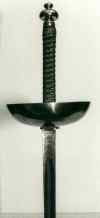
French epee,
c. 1890 |

French school
prize, 1891 |

French patented epee,
c. 1894 |
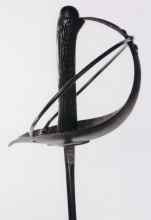
Italian sporting sabre,
c. 1875 |
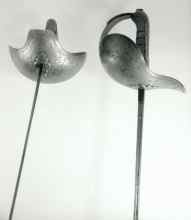
Italian duelling sabres,
c. 1890 |
|
The evolution of the mask can be seen from a simple face cover, followed
by the addition of ear and forehead protectors and a rudimentary bib, to
the full foil mask with leather bib or throat protector introduced in the
late 19th century. Unusual examples on display include a mid-19th
century Cossack sabre model with an extraordinary steel basket head
protector, a singlestick mask made of wickerwork and a beautifully
designed turn-of-the-century Italian sabre mask. |
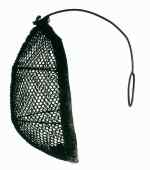
French, late 18th c.
|
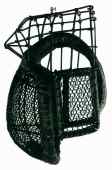
Russian, c. 1850
|
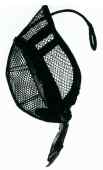
French, c. 1870
|
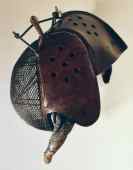
Italian, c. 1900
|
|
At the end of the 19th century bronze and spelter figures became
popular, particularly in France, and the museum has a few examples of
fencers and duellists in characteristic poses. |
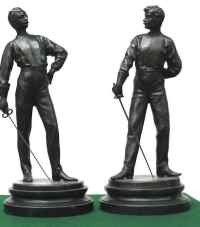
Foilists in evening dress
|
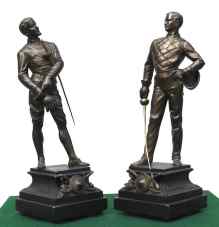
Pupil and master
|
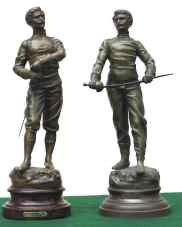
Epeeists by Raphanel
|
|
|
|
|
|
|
|
|
|
|
|
|
|
|
|
|
|
|
|
|
|
|
|
|

|